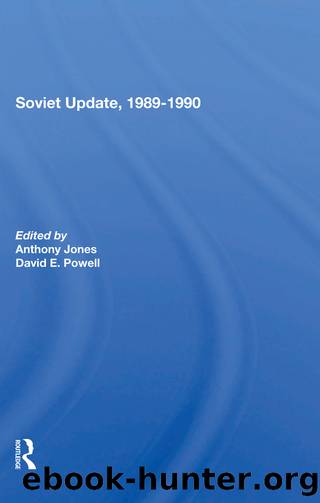Soviet Update, 1989-1990 by Anthony Jones David E. Powell

Author:Anthony Jones, David E. Powell [Anthony Jones, David E. Powell]
Language: eng
Format: epub
ISBN: 9781000312744
Barnesnoble:
Publisher: Taylor & Francis
Published: 2019-07-11T00:00:00+00:00
Expression of Popular Will by Mass Movements
For democracy to work, political participation had to become self-generating. A new kind of political activism from below increasingly flourished throughout 1989 and 1990, especially in the Western republics, where it sometimes took on national overtones. This mass activism manifested itself in informal groups, meetings, petition drives, demonstrations, and support for avoidance of the military draft. In the Baltic republics especially, the self-organization of peoples was amazingly quick, complete, and nonviolent, and led to the emergence of popular fronts as umbrella organizations for quickly spreading grassroots initiatives. The popular fronts believed that democracy could only be brought about by a process relying on dialogue and the power of ideas, and emphasized direct involvement in democracy through unprecedented mass manifestations.
The most impressive demonstration of popular will capturing the attention of people in the Soviet Union (as well as worldwide) occurred on August 23, 1989. About two million Estonians, Latvians, and Lithuanians, as well as independent minded non-Baits, joined hands and formed a human chain across the three Baltic States to protest the consequences of the Hitler-Stalin Pact for their nations. While marking the continued effects of this infamous pact on its fiftieth anniversary, the Baits standing in this human chain also expressed their commitment to restoring their independent states.3 Known as the demonstration of the "Baltic Way" this human chain became a watershed in Baltic self-assertion. It expressed a new political commitment and self-confidence, similar in effect to the first visit of the Pope to Poland in 1979. As in Poland, the experience of being able to organize and carry out without incident such a mass event was psychologically liberating. It was also a concrete expression of Baltic solidarity, to be continued from then on in other forms.
On August 23, 1989, the three popular fronts passed a declaration defining their political approach: "The Baltic Way is a parliamentary way for the peaceful restoration of our statehood. The Baltic Way will guarantee social security, civil rights, and economic progress to all peoples in the Baltic republics regardless of their nationality."4 The underlying idea is that for numerically small peoples political power lies in moral strength, non-violent struggle, and persistence in the pursuit of just goals. The effectiveness of such a strategy was shown a few days later. On August 26, the Central Committee of the CPSU accused the Baits of nationalist hysteria and threatened them with tanks,5 but when Baltic leaders repudiated this attack there was silence followed by surprisingly conciliatory statements. In fact, vacillation between threats and conciliation has emerged as a typical trait of Gorbachev's ethnic policy.
In part, the ambivalent posture of the central leaders can be explained by their hopes to co-opt the popular mass movements for the support of perestroika. The center encouraged the founding of broad democratic movements such as the popular fronts, or "Popular Movements for Perestroika" as they were called in Ukraine, Lithuania, and elsewhere. At least in the first stages, these movements were led by reformist Communists eager for compromise.
Download
This site does not store any files on its server. We only index and link to content provided by other sites. Please contact the content providers to delete copyright contents if any and email us, we'll remove relevant links or contents immediately.
| Africa | Americas |
| Arctic & Antarctica | Asia |
| Australia & Oceania | Europe |
| Middle East | Russia |
| United States | World |
| Ancient Civilizations | Military |
| Historical Study & Educational Resources |
Red Famine: Stalin's War on Ukraine by Anne Applebaum(2470)
Chernobyl by Serhii Plokhy(2131)
Midnight in Chernobyl by Adam Higginbotham(2081)
The House of Government by Slezkine Yuri(1847)
Midnight in Chernobyl: The Untold Story of the World's Greatest Nuclear Disaster by Adam Higginbotham(1776)
Red Shambhala by Andrei Znamenski(1752)
The Gulag Archipelago (Vintage Classics) by Aleksandr Solzhenitsyn(1730)
From Cold War to Hot Peace by Michael McFaul(1714)
All the Kremlin's Men by Mikhail Zygar(1703)
Putin's Labyrinth(1662)
Red Notice by Bill Browder(1596)
The Future Is History by Masha Gessen(1593)
From Russia with Lunch by David Smiedt(1553)
A People's Tragedy by Orlando Figes(1545)
The Romanovs by Simon Sebag Montefiore(1493)
How to Tame a Fox (and Build a Dog): Visionary Scientists and a Siberian Tale of Jump-Started Evolution by Lee Alan Dugatkin & Lyudmila Trut(1469)
Putin's Labyrinth: Spies, Murder, and the Dark Heart of the New Russia(1457)
The Lost Spy by Andrew Meier(1399)
Art and Revolution by John Berger(1391)
